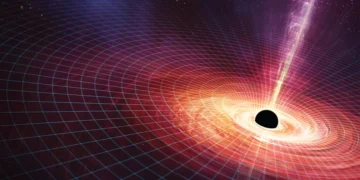Imagine a power source so immense that it dwarfs all the energy produced by stars, including our Sun. This isn’t science fiction but a theoretical possibility rooted in the enigmatic nature of rotating black holes. Recent research by physicist Jorge Pinochet explores how advanced civilizations—or perhaps humanity in the distant future—might extract energy from these cosmic behemoths.
Theoretical Foundations: Penrose Process and Ergosphere Dynamics
In 1969, Sir Roger Penrose introduced a groundbreaking concept suggesting that energy could be extracted from a rotating black hole. This idea, known as the Penrose Process, leverages the unique properties of the ergosphere—a region outside the event horizon where space-time is dragged around the black hole.
Within the ergosphere, particles can achieve negative energy states relative to an observer at infinity. If a particle is introduced into this region and then split, one fragment can fall into the black hole with negative energy, while the other escapes with more energy than the original particle had. This process effectively extracts rotational energy from the black hole.
Although this concept is revolutionary, practical implementation remains incredibly complex. To extract energy using the Penrose Process, one would require extreme precision, as well as a mechanism for controlling the movement and division of particles near the black hole.
Ergosphere Dynamics: The Key to Energy Extraction
The ergosphere is a crucial region for energy extraction. Unlike other areas around black holes, objects within the ergosphere must rotate due to the extreme frame-dragging effect caused by the black hole’s spin.
This means that particles and even entire spacecraft could be accelerated to relativistic speeds without requiring an external power source. Theoretically, an advanced civilization could harness this effect to generate enormous amounts of energy or even propel spacecraft to near-light speeds.
Mechanisms of Energy Extraction: Beyond the Penrose Process
While the Penrose Process provides a theoretical framework for energy extraction, it presents significant practical challenges. An alternative mechanism, known as the Blandford-Znajek Process, offers a more feasible approach.
Proposed by Roger Blandford and Roman Znajek in 1977, this process involves extracting energy from a rotating black hole through magnetic fields rather than particle interactions.
A strong magnetic field near the black hole interacts with its rotation, inducing electromagnetic forces that can accelerate charged particles away from the black hole. This process is believed to power the enormous relativistic jets observed in quasars and active galactic nuclei, where energy is extracted from the black hole and ejected into space.
Astrophysical Jets: Natural Evidence of Energy Extraction
Observations of astrophysical jets provide empirical evidence supporting energy extraction mechanisms like the Blandford-Znajek Process. These jets, composed of high-energy particles, shoot out from the poles of black holes at nearly the speed of light.
Scientists believe that these jets are directly powered by the rotational energy of black holes. By studying them, we gain insight into how energy extraction occurs naturally in the universe—and how we might one day replicate this process.
Recent Research and Developments: Pinochet’s Analysis
Building upon these foundational theories, physicist Jorge Pinochet has conducted an in-depth analysis of the feasibility of harnessing energy from rotating black holes. His research explores the efficiency of energy extraction processes and the potential mechanisms that could be employed by advanced civilizations.
Pinochet emphasizes that while the Penrose Process is theoretically sound, its practical implementation is fraught with challenges, such as precise control over particle interactions within the ergosphere. In contrast, the Blandford-Znajek Process offers a more viable pathway, as it relies on naturally occurring magnetic fields and plasma interactions.
Technological Implications: A Glimpse into the Future
Harnessing energy from black holes would signify a monumental leap in technological capability. According to the Kardashev Scale—a framework for measuring a civilization’s technological advancement based on energy consumption—a society that could exploit such energy sources would be classified between Type II (harnessing the energy of an entire star) and Type III (utilizing the energy of an entire galaxy).
This concept aligns with the Transcension Hypothesis, which proposes that advanced civilizations may eventually seek energy sources beyond planetary systems, potentially tapping into the rotational energy of black holes.
Practical Considerations and Challenges: Bridging Theory and Reality
Technological Limitations: The Roadblocks Ahead
Despite the incredible potential of extracting energy from black holes, several formidable challenges stand in the way. The extreme environments near black holes involve intense gravitational forces, high-energy radiation, and complex magnetic fields, all of which pose significant obstacles to current technology.
Developing the means to approach, interact with, and safely extract energy from these regions would require unprecedented advancements in engineering, materials science, and space travel.
Ethical and Philosophical Implications: Power and Responsibility
Harnessing the energy of black holes also raises profound ethical and philosophical questions. The immense power associated with such endeavors could have far-reaching consequences, potentially altering the balance of civilizations and impacting the broader cosmos.
Would such technology be used responsibly? Could it be weaponized? These are questions that must be considered if energy extraction from black holes ever becomes a reality.
Conclusion: The Promise and Peril of Cosmic Energy
The prospect of extracting energy from rotating black holes represents one of the most ambitious and intriguing possibilities in modern astrophysics. While current technological limitations make this a distant goal, ongoing research continues to shed light on the underlying physics and potential pathways to harness this cosmic powerhouse.
Reference:
Pinochet, J. (2025). Rotating black holes: The most fantastic source of energy in the universe. arXiv preprint. https://arxiv.org/abs/2502.15784



















